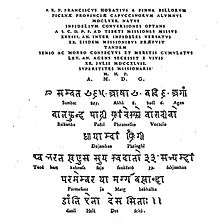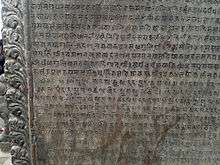Stone inscriptions in the Kathmandu Valley



Stone inscriptions in the Kathmandu Valley refer to ancient stone slabs, pillars and pedestals with text carved on them. They are the most important sources for the history of Nepal. A vast majority of the inscriptions found in Nepal are from the Kathmandu Valley where they are an ubiquitous element at heritage sites. They consist of royal edicts and dedicatory notes on Hindu and Buddhist temples, stupas, statues, water spouts and other architectural structures.[1]
The early inscriptions are from the Licchavi period, and date from the fifth to the ninth centuries. They number more than 170, and are carved in Sanskrit language and Gupta script.[2][3] Inscriptions from the 14th century onwards, which are the most numerous, are in Nepal language (Nepal Bhasa) and Nepal script.[4] The earliest dated inscription in Nepal Bhasa is dated Nepal Era 293 (1173 AD).[5]
Oldest inscription
The oldest dated inscription in Kathmandu dates from the year 207 of the Saka era which corresponds to 285 AD. It is carved in Gupta characters, also known as Brahmi script, on the pedestal of a statue of King Jayavarman. It was unearthed at a building site in Maligaon in 1992. The language is Sanskrit.[6]
Prior to this discovery, the distinction of the oldest dated stone inscription in the valley was held by an inscription carved on a pillar installed next to the Changu Narayan Temple in Bhaktapur which is dedicated to a Hindu deity Vishnu. It was inscribed in the year 383 which corresponds to 464 AD. It is written in the Sanskrit language and Gupta characters.[7]
Multilingual inscriptions
Among the thousands of Nepal language inscriptions scattered across Nepal Mandala, or the Kathmandu Valley and its neighborhood, there are a few inscribed in other languages too. King Pratap Malla's polyglot inscription dated Nepal Era 774 (1654 AD) at Kathmandu Durbar Square is an example of his linguistic interest. The massive stone with spouts to dispense water to travelers is carved in 15 languages including English, French and Persian.[8]
Three inscriptions in the Nepali language have been found in the Kathmandu Valley. There is one at Makhan dated 1641 AD. Another at Guheswari bears the name Pratap Malla. Another famed stone inscription of Pratap Malla installed at Rani Pokhari pond contains writings in three languages: Sanskrit, Nepali and Nepal language. It is dated Nepal Era 790 (1670 AD) and describes the construction of Rani Pokhari and its religious significance.[9][10]
A large stone inscription containing texts in Nepal language and Tibetan is installed at the Swayambhu stupa complex. It records the renovation of the stupa during the years 1751-1758.[11] The epitaph on the tombstone of a Capuchin missionary named Francesco della Penna, who died and was buried in Patan in 1745, contains texts in Latin and Nepal Bhasa.[12]
Gallery
-
 Inscription at Swayambhu, Kathmandu.
Inscription at Swayambhu, Kathmandu. -
 Inscription of Nepal Era 1021 (1901) at Dhalasikwa, Kathmandu.
Inscription of Nepal Era 1021 (1901) at Dhalasikwa, Kathmandu. -
 Nepal Bhasa inscription dated Nepal Sambat 902 (1782) at Swayambhu.
Nepal Bhasa inscription dated Nepal Sambat 902 (1782) at Swayambhu. -
 Inscription in Nepal Bhasa at Asan dated Nepal Sambat 1044 (1924).
Inscription in Nepal Bhasa at Asan dated Nepal Sambat 1044 (1924). -
 Inscription in Nepal script at Swayambhu, Kathmandu.
Inscription in Nepal script at Swayambhu, Kathmandu. -
 Inscription in Nepal Bhasa and Nepal script dated Nepal era 821 (1701).
Inscription in Nepal Bhasa and Nepal script dated Nepal era 821 (1701). -
 Inscription at Balambu
Inscription at Balambu -
 Inscription dated 25 March 2014 at Kamalachhi
Inscription dated 25 March 2014 at Kamalachhi
References
- ↑ Gutschow, Niels (1997). The Nepalese Caitya: 1500 Years of Buddhist Votive Architecture in the Kathmandu Valley. Edition Axel Menges. p. 25. ISBN 9783930698752. Retrieved 25 March 2014.
- ↑ Vajracarya, Gautamavajra. "Recently discovered inscriptions of Licchavi Nepal" (PDF). Kailash: 117–133. Retrieved 9 March 2014.
- ↑ "Arvind", Krishan Dev Agrawal (2010). Importance of Nepalese Sanskrit Inscriptions (PDF). New Delhi: Rashtriya Sanskrit Sansthan. ISBN 978-81-86111-37-6. Retrieved 19 March 2014.
- ↑ Clark, TW (1976). "Nepali and Pahari". In Albert Sebeok, Thomas. Current Trends in Linguistics. Walter de Gruyter. p. 253.
- ↑ Malla, KP. "Classical Newari Literature" (PDF). p. 1. Retrieved 19 March 2014.
- ↑ Tamot, Kashinath; Alsop, Ian. "A Kushan-period Sculpture from the reign of Jaya Varma, A.D. 184/185". Asian Arts. Retrieved 25 March 2014.
- ↑ Riccardi, Jr, Theodore (Oct–Dec 1989). "The Inscription of King Manadeva at Changu Narayan". Journal of the American Oriental Society. 109 (4): 611. doi:10.2307/604086. Retrieved 13 March 2014.
- ↑ Giuseppe, Father (1799). Account of the Kingdom of Nepal. London: Vernor and Hood. pp. 313–314. Retrieved 14 March 2014.
- ↑ Clark, TW (1976). "Nepali and Pahari". In Albert Sebeok, Thomas. Current Trends in Linguistics. Walter de Gruyter. p. 253.
- ↑ Tribhuvan University Teachers' Association (June 2012). "Historical and Environmental Study of Rani Pokhari". Government of Nepal, Ministry of Environment, Science and Technology. pp. 4–5. Retrieved 14 March 2014.
- ↑ Ehrhard, Franz-Karl. "A Renovation of Svayambhunath-Stupa in the 18th Century and its History" (PDF). Ancient Nepal: 1–8. Retrieved 14 March 2014.
- ↑ Lévi, Sylvain (1908). Le Népal: étude historique d'un royaume hindou. E. Leroux. p. 107. Retrieved 17 March 2014.